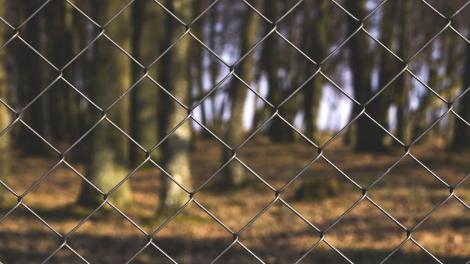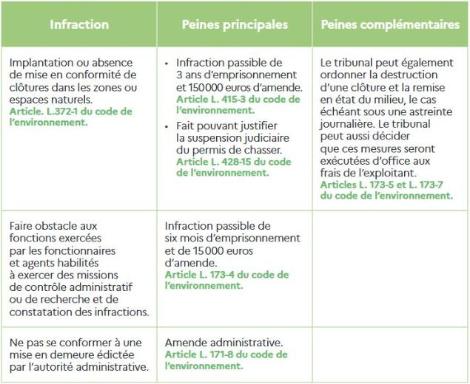Ensuring ecological continuity
Limiting encroachment into natural areas
January 2025
Over the years, many landowners have erected fences over all or part of their land to prevent access by walkers, but above all to allow hunting: hunting in the enclosures was permitted all year round and the game could be held captive. Promulgated on 2 February 2023, the law aimed at limiting encroachment on natural areas and protecting private property provides for the restoration of ecological continuity so that animal species can move freely in natural areas. By 1 January 2027, the law will require all existing fences that are less than 30 years old to be brought into compliance. For new fences, these conditions apply with immediate effect.
To download : ofb_plaquette_engrillagement_bd.pdf (770 KiB)

Why a law on enclosures?
Deer, roe deer, hedgehogs or toads: wild animals need a vast territory to access the breeding, feeding or resting areas they need to complete their life cycle. By fragmenting habitats that have already been put to the test by urbanisation, the encroachment of natural areas jeopardises the survival of wild fauna and also causes direct injury and death to animals that try to cross these obstacles. Although the Civil Code has recognised the right to fence off property and hunt there since 1804, the development of these fences is now undermining the preservation of biodiversity and the health of wild animal populations. The concentration of species in hunting enclosures and fenced estates leads to heavy trampling of the forest environment and weakens some forests, which are no longer able to regenerate. Finally, when forest fires occur, the increase in the number of fences hinders access by emergency services and slows the spread of the fire. With climate change, periods of drought are intensifying, increasing the vulnerability of forests to fire throughout the country.
In view of these challenges, Law 2023-54 of 2 February 2023 aims to limit the encroachment of natural areas. Following a referral from members of parliament, the Constitutional Council validated the content of the law on 18 October 2024, reconciling property rights and environmental protection. Officers from the French Office for Bio-diversity, the Departmental Territorial Directorate and the National Gendarmerie are empowered to monitor compliance with the rules set out in this law and to detect any infringements, under the authority of the Departmental Prefect and the Public Prosecutor.
What the law says
The law of 2 February 2023 lays down the following principle: fences erected in natural areas and more than 150 metres from a dwelling must allow wild animals to move freely at all times.
Fences must meet all of the following requirements:
-
They must not be harmful or constitute traps for wildlife
-
Be no more than 1.20 m high (from the ground)
-
Be set 30 cm above the ground
-
Be made of natural or traditional materials
Scope The law applies to the whole of France, with the exception of ultra-marine local authorities with environmental jurisdiction. It applies to fences erected in areas classified as natural or forested by the regulations of the local town planning scheme (PLU). In the absence of a PLU, only fences located ‘in natural areas’ are concerned, and not fences found in urban or peri-urban areas.
Hunting enclosures and hunting parks, which are affected by the ‘Engrillagement’ law, are also subject to new rules: the obligation to have a management plan, to comply with the opening and closing dates for hunting and to prohibit the use of staples, except where provided for in the departmental game management plan.
What are the administrative obligations?
-
If you own land in a natural area or space and you wish to erect a fence at the boundary of your property, you must submit a prior declaration to your local town planning department.
-
If you own fenced land in a natural area or space and you wish to comply with the law of 2 February 2023: you must make a prior declaration to the Prefecture, which will ensure that the return to free movement in the natural environment of wild animals that have lived in an enclosure does not present a health risk for the rest of the wildlife.
Penalties incurred
The ‘Engrillagement’ law may give rise to administrative and/or legal proceedings, depending on the policy determined in each département by the prefect and the public prosecutor. In the first case, the owner will receive a letter of formal notice to comply. In the second case, the owner will be summoned for a hearing, after which the public prosecutor will decide on the penalty (see table). In judicial terms, the law of 2 February 2023 created a new offence to punish failure to comply with the above rules, specified in article L.372-1 of the Environment Code.

Statutory exemptions
The requirements laid down by law to allow the free movement of wildlife through natural areas have been amended by the legislator, who has provided for derogations in the 9 cases listed below. To ensure that the provisions are clear and understandable to the landowners concerned and that all citizens are equal before the law, the Ministry of the Environment and the French Biodiversity Office have drawn up the following guidelines in the light of the parliamentary debates that led to the adoption of the law.
1. Fences for hunting dog training parks, competitions or trials These activities are governed by a ministerial order dated 21 January 2005, amended, following the ‘Engrillagement’ law, by an order dated 8 April 2024. The following conditions must be met in order to legally carry out these activities and qualify for an exemption: authorisation must be sought from the departmental prefect prior to the organisation of any hunting dog training, competitions or events; such events must have been organised for at least 20 days a year during the previous year; a maximum of 5 days of collective big game hunting must be organised in these areas.
2. Fencing for horse farms. Equine breeding activities are considered to be agricultural activities.
3. Fences erected for scientific purposes Any activity governed by the research code (e.g. agronomic programme) and the heritage code (e.g. archaeological digs) will be considered.
4. Fences of a historical or heritage nature The following are considered as such: fences listed or registered as historical monuments; fences constituting a distinctive feature of a natural monument or a site classified by the Sites Commission.
5. National estates The list and perimeter of these estates are defined by the French Heritage Code (article R. 621-98). They include Chambord (Loir-et-Cher), Pierrefonds (Oise) and Villers-Cotterêts (Aisne), Compiègne (Oise), Fontainebleau (Seine-et-Marne) and Rambouillet (Yvelines).
6. Fences erected around plots of land used for farming. This exemption only applies to agricultural activities as defined in article L.311-1 of the French Rural and Maritime Fishing Code, carried out as a main professional activity. Activities carried out for leisure or as an accessory to a main professional activity that is not agricultural in nature are excluded.
7. Fences required to trigger and protect forest regeneration. This exemption is based on the criteria of triggering and protection, which are cumulative and not alternative. The need to use fencing must be temporary and justified by a sylvo-cynégétique imbalance: any forest regeneration can claim to benefit from this exception if the absence of fencing is likely to jeopardise forest regeneration. This exception is no longer admissible once the forest plot concerned reaches a stage where the absence of fencing is no longer likely to jeopardise regeneration. This exception does not apply simply because a forest plot is being farmed.
8. Fences around gardens open to the public. A number of indicators will be taken into account, such as the fact that the premises are open to the public and the existence of municipal regulations governing parks and gardens.
9. Fences required for national defence, public safety or any other public interest. The following will be considered: military, defence and security zones; infrastructures for transporting people or goods (airfields, seaports, railways, motorways, roads with a high volume of traffic or particularly accident-prone roads); electricity production installations, sites for researching and exploiting natural gas and oil deposits, oil installations.